Raaga Based Song of the Day: Chhup gayaa koi re, door se pukaar ke,
Dard anokhe haay, de gayaa pyaar ke….
Raag Jhinjhoti, Tal Kaherava
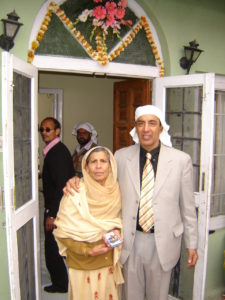 Whilst this is a great song, no doubt, I am sure this is the first time someone would have made use of the song to remember his late mother. Now, why did I do it? There are several reasons. The first one is that the lyrics (don’t forget I am a Lyrical man) are most appropriate to express my feelings after my mother has gone to reside with God. Take this, for example:
Whilst this is a great song, no doubt, I am sure this is the first time someone would have made use of the song to remember his late mother. Now, why did I do it? There are several reasons. The first one is that the lyrics (don’t forget I am a Lyrical man) are most appropriate to express my feelings after my mother has gone to reside with God. Take this, for example:
Akhiyon se neend gayi, manvaa se chain re
Chhup chhup roye mere, khoye khoye nain re…
The lyrics express exactly what I am going through.
The second is that if you can take a filmy-song tune to make a bhajan (hymn) – and in the temples there are quite a few of them – why can’t I take this superb song in remembrance of my mother?
The third, of course, is that the raag happens to be Jhinjhoti, a raag named after an apsara and my most favourite song in Hindi movies happens to be in this raag; which I have always decided, for emotional reasons, never to put up: Mere mehboob tujhe meri mohabbat ki kasam. If you recall, my first post in the series was in Raag Jhinjhoti titled ‘Raaga Based Song Of The Day #1’ and the song was a Mohammad Rafi and Lata Mangeshkar song from the 1970 Shakti Samanta movie Pagla Kahin Ka: Tum mujhe youn bhula na paoge. It is in Raag Jhinjhoti, Tal Kaherava.
The fourth is that I am very fond of Hemant Kumar and this song has his composition as a music director.
Last, but not the least is that it has been sung by Lata Mangeshkar and my fondness for her singing is already well-known (Please read: ‘My Favourite Songs Of Lata Mangeshkar‘). My mom used to say that in me (being the middle child between my elder sister and younger brother) she obtained both a son and a daughter since, whilst looking after all those things that only a man can, I never shied from working in the kitchen or doing those things too that women do so well. Hence, it is not inappropriate for me to select a Lata Mangeshkar song to express my sentiments.
My last post, that is, the fifty-fifth post was also a tribute to my late mother who suddenly passed away on 09 Aug 17. It was titled ‘Raaga Based Song Of The Day #55‘ and the song was a Mohammad Rafi song from the 1955 SU Sunny movie Udan Khatola: O door ke musaafir, hamko bhi saath le le re, ham reh gaye akele. It is in Raag Pahadi, Tal Kaherava.
This blog has a number of posts on Raaga based songs in Hindi movies titled similarly; for example: ‘The Best Raaga Based Songs in Hindi Movies – Raaga Pilu – Part I‘.
In the last fifty-five days of sharing Raaga based songs of the day, I have given you songs based on Raag Jhinjhoti, Gara, Bhimpalasi, Madhuvanti, Shivaranjani, Bihag, Pahadi, Sarang, Pilu, Bhairavi, Khammaj, Charukesi, Kalyan or Yaman, Desh, Malgunji, Kirwani, Kedar, Bageshri, Megh Malhar, Bhupali, Ahir Bhairav, Malkaush, Mand, Adana, Kafi, Rageshri, Jaunpuri, Tilang, Janasammohini, Chayanat, Shuddha Kalyan, Gaur Sarang, Jogiya, Asavari, Maru Bihag, Durga, Lalit, Puria Dhanashri, Bhinna Sahdja, Sohani, Multani, Patdeep, Jaijaiwanti, Tilak Kamod, Hemant, Basant Mukhari, Gujri Todi, Kalavati and Hamir. The only three raag that has been repeated so far are Pahadi, the raaga of my home place in the Himalayas, Maru Bihag and Raag Kirwani. That makes a total of 49 raagas so far; today’s one too I am repeating: Raag Jhinjhoti.
Today, I give you a song, in Raag Jhinjhoti, Tal Kaherava, one of the best of Lata Mangeshkar.
However, first, lets take up the value added learning of today. Today, we shall learn about Santoor.
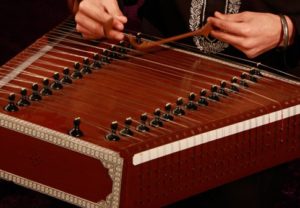
Just like Veena, Santoor is an ancient instrument of India. It was origibnally called Shata-tantri Veena which means a Veena of shata or hundred strings. I already brought out to you in an earlier post that Veena wasn’t a specific instrument at one time; any string instrument used to be called Veena at one time. I had already brought out that the first of these was called Pinaki-Veena (Please refer to ‘Raaga Based Song Of The Day #48‘). Interestingly, Pinaki Veena was created from the idea of bow and arrow; as the latter was released from the bow, it made a sound. It is similar to Western instrument Harp. Its miniature version is called Swarmandal, that we shall take up later.
Santoor is a hollow box made of walnut. Atop the box are 25 bridges, each having four strings resting on it. Two wooden mallets, one each balanced in each hand are used to paly Santoor.
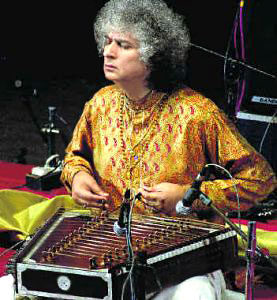
The most populzar image of Santoor player is that of Pandit Shivkumar Sharma; I have listened to him live many times. It was actually his father Pandit Umadutt Sharma who brought this instrument from Kashmir wherein it was used with Sufi music and introduced it into Indian classical music.
Shivkumar Sharma was initiated into classical music at the age of five as a vocalist and tabla player. He later became so adept at playing Santoor that the name Shivkumar Sharma and Santoor became inseparable. Indeed, he improved its tonal quality, its playing technique, in the range and bhaav of music.
The modified Santoor which Shivkumar Sharma plays now has got 31 bridges, with a total number of 91 strings. It has got a range of 3 octaves and chromatic tuning.
As I mentioned, today’s song is composed in Raag Jhinjhoti, Tal Kaherava.
Raag Jhinjhoti is a raag of Khammaj Thaat. Its Jati is Audhav-Sampurna, that is five notes ascending (Aaroha) and all seven notes in descending (Avaroha). The time for the raag is second Prahar of the night (nine PM to midnight). Jhinjhoti is regarded as a light raag. Nevertheless it is practised in both dhrupad and khayal tradition by vocalists as well instrumentalists. The raag is commonly used in semi-classical genres of tappa and thumri that I have already told you about.
Most songs in Hindi movies that have been composed in Raag Jhinjhoti have an element of self-pity about them. Some of the songs composed in this raaga are:
| 1. 2. 3. 4. 5. 6. 7. 8. 9. 10. 11. 12. 13. 14. 15. 16. 17. 18. 19. 20. 21. 22. 23. 24. 25. 26. |
Badli Badli Duniya Ik Raat Mein Do Do Sakhi Ri Pi ka Naam Ik Pyar Ka Bandhan Kuchh hamein Chahiye Mose Chhal Kiye Jaye Kya Se Kya Ho Gaya Piya Bin Nahi Aawat Sari Duniya Se Dil Ke Tukde Hue Piya Bin Chal Pi Ke Milan Phir Teri Kahani Yaad Rehete the Kabhi Jinke Jab Chhaye Kabhi Ta The Ee Tat Thaee Teri Aankh Ke Aansoo Sun Ayeri Sakhi Chali Banke Dulhan Koi Humdum Na Raha Ja Ja Re Ja Baalamwa Bheeegi Palkein Raat Nikhari Hui Hum Aaj Kaheen Dil Sansaar Se Bhage Aaj Hai Pyar Ka Faisala |
Sangeet Samrat Tansen Barkha Sati Savitri Pyar Ka Bandhan Char Dil Char Raahen Guide Guide Pativrata Milan Son Of India Miyan Biwi Razi Ziddi Dil Diya Dard Liya Mamta Reshmi Roomal Tere Mere Sapne Jahanara Naata Subah Ka Tara Jhumroo Basant Bahar Do Gunde Hum Hindustani Andaaz Chitralekha Leader |
Mahendra, Lata Mukesh, Lata Lata Asha Lata Lata Rafi Bhimsen Joshi, Laxmi Shankar Lata Lata Mahendra, Asha Shamshad Lata Lata Talat Mahmood Asha Talat Lata Lata Kishore Lata Lata, Rafi Mukesh Mukesh Lata Lata |
As far as Tal Kaherava is concerned, I have already told you enough about this most popular Tal.
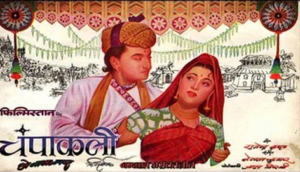 Of course, I have made use of the song in memory of my late mother. The song, originally, is from the 1957 Nandlal Jaswantlal movie Champakali starring Bharat Bhushan, Suchitra Sen and Pran. The song was penned by Shimla man Rajinder or Rajindra (he used both spellings) Krishan that has my mom’s name in part (Harkrishan). Rajinder Krishan was the richest lyricist in Hindi movies and my mom was thje richest person at heart that I know of.
Of course, I have made use of the song in memory of my late mother. The song, originally, is from the 1957 Nandlal Jaswantlal movie Champakali starring Bharat Bhushan, Suchitra Sen and Pran. The song was penned by Shimla man Rajinder or Rajindra (he used both spellings) Krishan that has my mom’s name in part (Harkrishan). Rajinder Krishan was the richest lyricist in Hindi movies and my mom was thje richest person at heart that I know of.
Please enjoy in Raag Jhinjhoti, Tal Kaherava: Chhup gaya koi re door se pukaar ke, Dard anokhe haay de gaya pyaar ke….
Chhup gayaa koii re, duur se pukaar ke
Dard anokhe haay, de gayaa pyaar ke
Chhup gayaa …
Aaj hai.n suunii suunii, dil kii ye galiyaa.N
Ban gaI.n kaa.NTe merii, khushiyo.n kii kaliyaa.N
Pyaar bhii khoyaa maine, sab kuchh haar ke
Dard anokhe haay, de gayaa pyaar ke
Chhup gayaa …
A.Nkhiyo.n se nii.nd gaI, manavaa se chain re
Chhup chhup roe mere, khoe khoe nain re
Haay yahii to mere, din the si.ngaar ke
Dard anokhe haay, de gayaa pyaar ke
Chhup gayaa …
We have intended to learn about Raaga based music whilst we entertain ourselves with Raaga based songs. So, lets, once again, take stock of our collective learning so far:
- On the first day we learnt about the Raaga system devised by Pandit Vishnu Narayan Bhatkhande, which is the prevalent system in Hindustani Classical Music and based on ten Thaats.
- On the second day we learnt about Tal or Taal.
- On the third day we learnt about characteristics of Raagas that included Swar, Jati, Thaat, Arohana and Avarohana, Vadi, Samvadi and Pakad.
- On the fourth day, we learnt about Sargam.
- On the fifth day, we learnt about notations used in Indian classical music or simply Swar Lipi.
- On the sixth day, we learnt about the Ras (sentiments) that Raagas evoke.
- On the seventh day, we learnt about various types of Swar: Shuddha, Achal, Vikrut, Komal and Teevra.
- On the eighth day, we learnt the parts of a composition in Indian Classical Music.
- On the ninth day, we learnt the names of some of the popular instruments used in Indian Classical Music.
- On the tenth day, we learnt about the sources of names of Raagas.
- On the eleventh day, we learnt about why Bhairavi is the first raag to be taught to beginners and also why it is the last in a performance.
- On the twelfth day, we learnt about Khammaj Thaat.
- On the thirteenth day, we learnt about Tal Punjabi Theka or Sitarkhani.
- On the fourteenth day, we learnt about Alap.
- On the fifteenth day, we learnt about List of Raagas (Raagmala) in my favourite book: Sri Guru Granth Sahib.
- On the sixteenth day, we learnt about tips for raaga identification.
- On the seventeenth day, we learnt the basics of Gharana system.
- On the eighteenth day, we learnt about Filmi Sangeet.
- On the nineteenth day, we learnt about the commonest Tal in Raagas: Tintal.
- On the twentieth day, we learnt about the Kafi Thaat.
- On the twenty-first day, we learnt a little more in detail about the classification of Raagas.
- On the twenty-second day, we learnt the essential differences between Bhairavi and Bhairav.
- On the twenty-third day, we learnt a little more in detail about the Jati or Jaati of a raaga.
- On the twenty-fourth day, we learnt details of Thaat Bilawal, the most basic thaat in the Bhatkhande’s system of raagas.
- On the twenty-fifth day, we learnt about Tintal.
- On the twenty-sixth day, we learnt in detail about the Raaga – Samay linkage.
- On the twenty-seventh day, we learnt about Lehar.
- On the twenty-eighth day, we learnt about the history of the Hindustani Music.
- On the twenty-ninth day, we learnt about Dhrupad.
- On the thirtieth day, we learnt about Rupaktal that I was introduced to, a few months back, by my friend Anand Desai.
- On the thirty-first day, we learnt about Khayal.
- On the thirty-second day, we learnt about Thumri.
- On the thirty-third day, we learnt about Tappa.
- On the thirty-fourth day, we learnt about Tarana.
- On the thirty-fifth day, we learnt about Tal Dipchandi (Moghali).
- On the thirty-sixth day, we learnt about Tabla.
- On the thirty-seventh day, we learnt about Kirtan.
- On the thirty-eighth day, we learnt about Pakhawaj.
- On the thirty-ninth day, we learnt about Hori.
- On the fortieth day, we learnt about Dadra.
- On the forty-first day, we learnt about Kajri.
- On the forty-second day, we learnt about Chaiti.
- On the forty-third day, we learnt about Sarangi.
- On the forty-fourth day, we learnt about Shehnai.
- On the forty-fifth day, we learnt about Sarod.
- On the forty-sixth day, we learnt about Bansuri.
- On the forty-seventh day, we learnt about Ektal and Tanpura.
- On the forty-eighth day, we learnt about Veena.
- On the forty-ninth day, we repeated our learning of Veena with a small excitement added.
- On the fiftieth day, we learnt about Dilruba/Esraj.
- On the fifty-first day, we learnt about Jaltarang.
- On the fifty-second day we learnt about Qawwali.
- On the fifty-third day, we learnt about Sitar.
- On the fifty-fourth day, we learnt about Surbahar.
- On the fifty-fifth day, we learnt about Harmonium.
- And today, on the fifty-sixth day, we learnt about Santoor.
There is much more still to be learnt and enjoyed.
Please stay tuned!
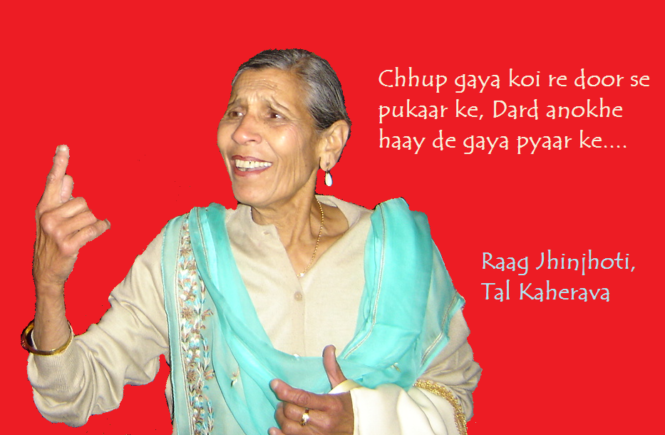
Lovely n heart rending song in order to purgation of soul . If one listen it closing his eyes and feeling melancholic , this song would provide catharsis and he would be a changed man , when he opens his eyes . These raga based posts are now at their best .
Thank you, Jaswant. Aptly commented